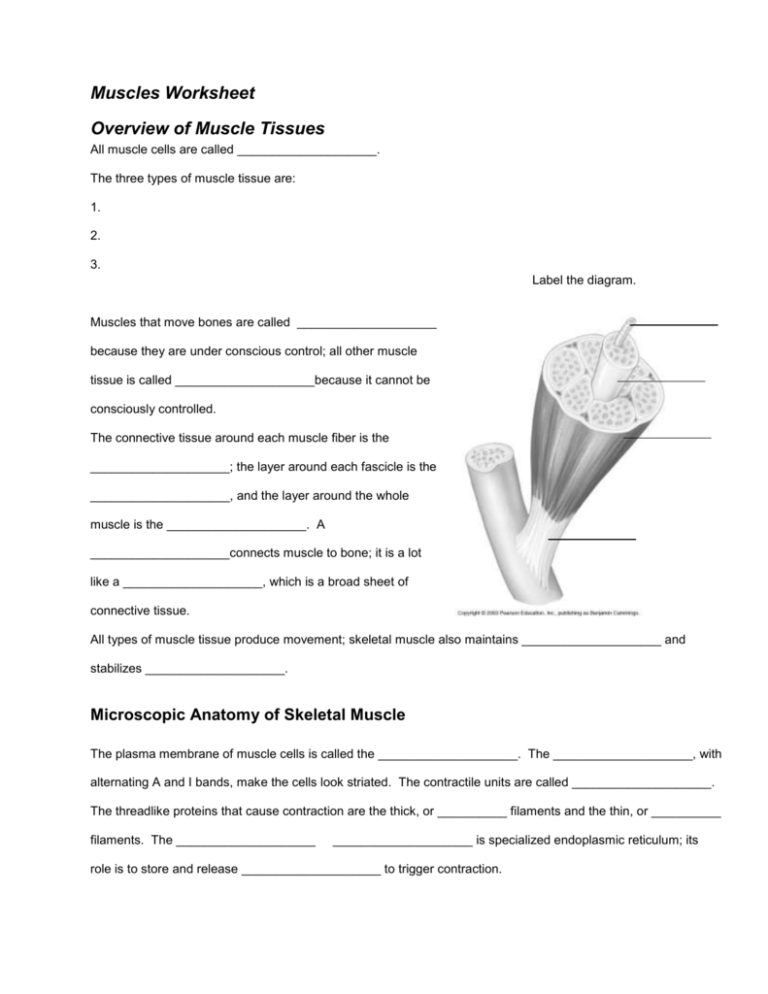Muscles Worksheet
advertisement

Muscles Worksheet Overview of Muscle Tissues All muscle cells are called ____________________. The three types of muscle tissue are: 1. 2. 3. Label the diagram. Muscles that move bones are called ____________________ because they are under conscious control; all other muscle tissue is called ____________________because it cannot be consciously controlled. The connective tissue around each muscle fiber is the ____________________; the layer around each fascicle is the ____________________, and the layer around the whole muscle is the ____________________. A ____________________connects muscle to bone; it is a lot like a ____________________, which is a broad sheet of connective tissue. All types of muscle tissue produce movement; skeletal muscle also maintains ____________________ and stabilizes ____________________. Microscopic Anatomy of Skeletal Muscle The plasma membrane of muscle cells is called the ____________________. The ____________________, with alternating A and I bands, make the cells look striated. The contractile units are called ____________________. The threadlike proteins that cause contraction are the thick, or __________ filaments and the thin, or __________ filaments. The ____________________ ____________________ is specialized endoplasmic reticulum; its role is to store and release ____________________ to trigger contraction. Label the diagram. filament filament Skeletal Muscle Activity One neuron and all the skeletal muscle cells it stimulates make up one ____________________ __________. The position on the muscle cell where the nerve fiber connects is called the ____________________ ____________________. The gap between the nerve ending and the muscle cell is the ____________________ ____________________. When the nerve impulse reaches the nerve ending, the chemical ____________________ is released. This chemical binds to the muscle cell membrane causing a temporary rush of ____________________ into the muscle cell. The electrical current generated along the muscle cell’s membrane is called an ____________________ ____________________ and is the signal to trigger contraction. A single contraction is called a ____________________; when contraction is prolonged, fused (or complete) ____________________ has occurred. Energy is provided for muscle contraction by ATP and its regeneration by direct phosphorylation by CP, or ____________________ ____________________. This can last about 20 seconds. Most energy at rest and with light exercise is provided by ____________________ ____________________, using glucose and other nutrient fuels (such as fatty acids). With intense exercise, ____________________ ____________________ and lactic acid formation occur. This leads to fatigue and a burning sensation in the muscles, along with oxygen debt, but quickly goes away when activity slows down. Muscle contractions in which the muscle shortens are called ____________________ contractions; if the muscle can’t shorten (because the load is too heavy, for example) then the contraction is called ____________________. Muscle Movements, Types, and Names The end that is stationary when a muscle contracts is the ____________________; the end that moves is the ____________________. Bending at a joint is called ____________________; straightening is ____________________. The muscle that is mostly involved in any specific action is called the ____________________ ____________________. Muscles that oppose the action are ____________________; muscles that help are ____________________. Match the muscle to the way they were named (note the underlined part of each name): 1. ________ Direction of muscle fibers A) Deltoid 2. ________ Relative size B) Triceps brachii 3. ________ Location C) Adductor magnus 4. ________ Number of origins D) Rectus abdominis 5. ________ Location of origin and insertion E) Gluteus maximus 6. ________ Shape F) Temporalis 7. ________ Action G) Sternocleidomastoid





